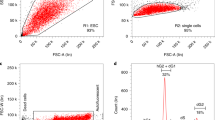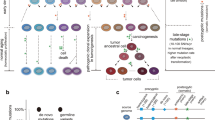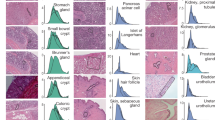Abstract
The drive to characterize functions of human genes on a global scale has stimulated interest in large-scale generation of mouse mutants. Conventional germ-cell mutagenesis with N-ethyl-N-nitrosourea (ENU) is compromised by an inability to monitor mutation efficiency, strain1 and interlocus2 variation in mutation induction, and extensive husbandry requirements. To overcome these obstacles and develop new methods for generating mouse mutants, we devised protocols to generate germline chimaeric mice from embryonic stem (ES) cells heavily mutagenized with ethylmethanesulphonate (EMS). Germline chimaeras were derived from cultures that underwent a mutation rate of up to 1 in 1,200 at the Hprt locus (encoding hypoxanthine guanine phosphoribosyl transferase). The spectrum of mutations induced by EMS and the frameshift mutagen ICR191 was consistent with that observed in other mammalian cells. Chimaeras derived from ES cells treated with EMS transmitted mutations affecting several processes, including limb development, hair growth, hearing and gametogenesis. This technology affords several advantages over traditional mutagenesis, including the ability to conduct shortened breeding schemes and to screen for mutant phenotypes directly in ES cells or their differentiated derivatives.
This is a preview of subscription content, access via your institution
Access options
Subscribe to this journal
Receive 12 print issues and online access
$209.00 per year
only $17.42 per issue
Buy this article
- Purchase on Springer Link
- Instant access to full article PDF
Prices may be subject to local taxes which are calculated during checkout


Similar content being viewed by others
References
Bode, V.C. Ethylnitrosourea mutagenesis and the isolation of mutant alleles for specific genes located in the T region of mouse chromosome 17. Genetics 108, 457–470 ( 1984).
Rinchik, E.M. & Carpenter, D.A. N-Ethyl-N-nitrosourea mutagenesis of a 6- to 11-cM subregion of the Fah-Hbb interval of mouse chromosome 7. Completed testing of 4557 gametes and deletion mapping and complementation analysis of 31 mutations. Genetics 152, 373–383 (1999).
Sega, G.A. A review of the genetic effects of ethyl methanesulfonate. Mutat. Res. 134, 113–142 ( 1984).
Klungland, A., Laake, K., Hoff, E. & Seeberg, E. Spectrum of mutations induced by methyl and ethyl methanesulfonate at the hprt locus of normal and tag expressing Chinese hamster fibroblasts. Carcinogenesis 16, 1281–1285 (1995).
Hsie, A.W., Brimer, P.A., Mitchell, T.J. & Gosslee, D.G. The dose-response relationship for ethyl methanesulfonate-induced mutations at the hypoxanthine-guanine phosphoribosyl transferase locus in Chinese hamster ovary cells. Somat. Cell Genet. 1, 247– 261 (1975).
Taft, S.A., Liber, H.L. & Skopek, T.R. Mutational spectrum of ICR-191 at the hprt locus in human lymphoblastoid cells. Environ. Mol. Mutagen 23, 96–100 (1994).
Chen, Y. et al. Genotype-based screen for ENU-induced mutations in mouse embryonic stem cells. Nature Genet. 24, 314– 317 (2000).
You, Y. et al. Chromosomal deletion complexes in mice by radiation of embryonic stem cells. Nature Genet. 15, 285– 288 (1997).
Ramirez Solis, R., Liu, P. & Bradley, A. Chromosome engineering in mice. Nature 378, 720–724 (1995).
Zheng, Q.Y., Johnson, K.R. & Erway, L.C. Assessment of hearing in 80 inbred strains of mice by ABR threshold analyses. Hear. Res. 130, 94–107 (1999).
John, S.W. et al. Essential iris atrophy, pigment dispersion, and glaucoma in DBA/2J mice. Invest. Ophthalmol. Vis. Sci. 39, 951–962 (1998).
Smith, R.S., Roderick, T.H. & Sundberg, J.P. Microphthalmia and associated abnormalities in inbred black mice. Lab. Anim. Sci. 44, 551– 560 (1994).
Kessel, M. & Gruss, P. Homeotic transformations of murine vertebrae and concomitant alteration of Hox codes induced by retinoic acid . Cell 67, 89–104 (1991).
Acknowledgements
We thank T. Magnuson for CT129 ES cells; T. Gridley for CJ7 ES cells; A. Planchart for input on design of culture experiments; J. Sztein for assistance with sperm examination; C. O'Neill for animal care; and T. O'Brien, G. Cox, T. Magnuson and M.A. Handel for critical evaluation of the manuscript. This work was supported by NIH grant GM45415 to J.C.S. and a Cancer Center Grant CA34196 to The Jackson Laboratory V.L.B. was supported by an NIH training grant (HD07065) and fellowship NIH (HD08441). S.W.M.J. is an Assistant Investigator of The Howard Hughes Medical Institute. Hearing tests were performed under a contract (DC62108) to K. Johnson from the National Institute on Deafness and Other Communicative Disorders.
Author information
Authors and Affiliations
Corresponding author
Rights and permissions
About this article
Cite this article
Munroe, R., Bergstrom, R., Y Zheng, Q. et al. Mouse mutants from chemically mutagenized embryonic stem cells. Nat Genet 24, 318–321 (2000). https://doi.org/10.1038/73563
Received:
Accepted:
Issue Date:
DOI: https://doi.org/10.1038/73563
This article is cited by
-
Identification of Nanog as a novel inhibitor of Rad51
Cell Death & Disease (2022)
-
LIG4 mediates Wnt signalling-induced radioresistance
Nature Communications (2016)
-
A homozygous mutant embryonic stem cell bank applicable for phenotype-driven genetic screening
Nature Methods (2011)
-
DNA repair: the culprit for tumor-initiating cell survival?
Cancer and Metastasis Reviews (2011)
-
Molecular characterization of an allelic series of mutations in the mouse Nox3 gene
Mammalian Genome (2011)



